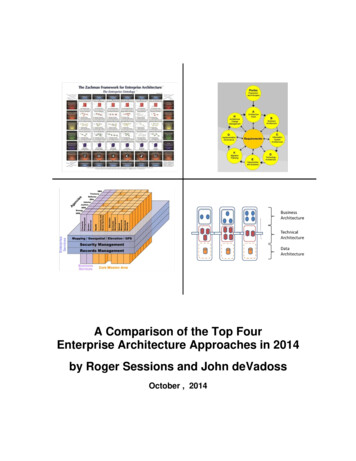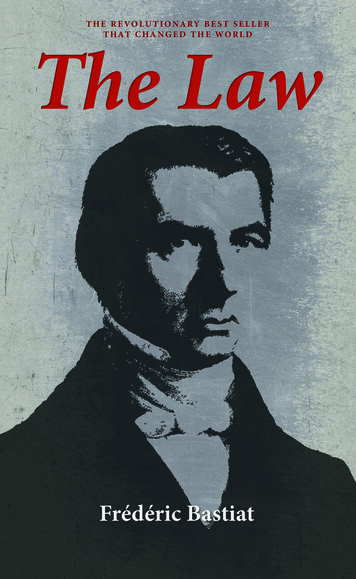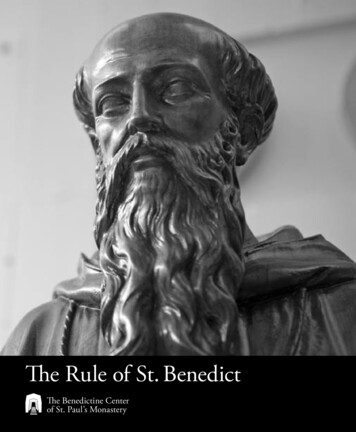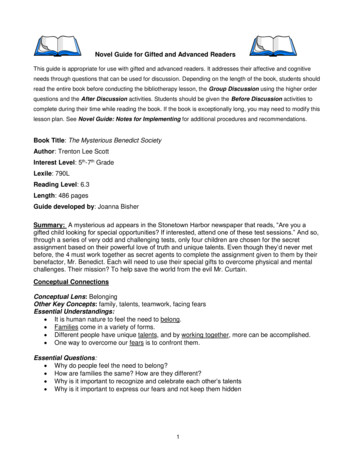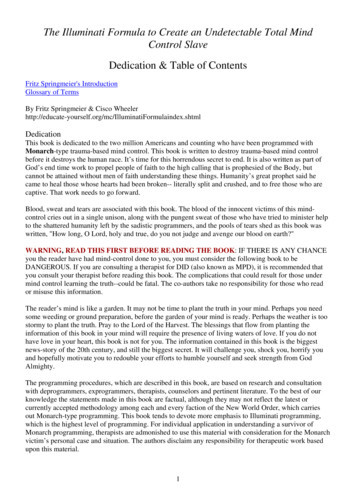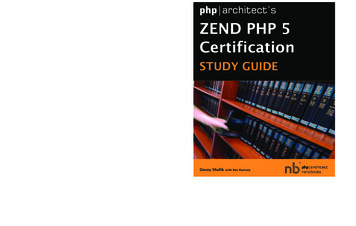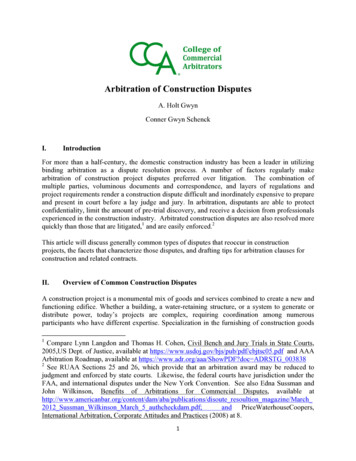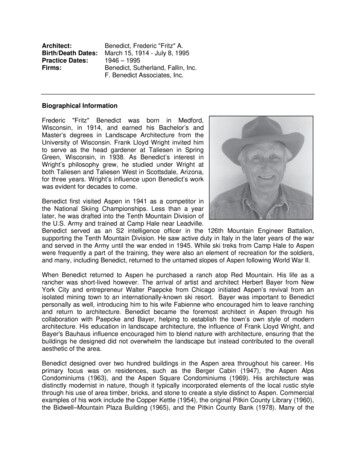
Transcription
Architect:Birth/Death Dates:Practice Dates:Firms:Benedict, Frederic "Fritz" A.March 15, 1914 - July 8, 19951946 – 1995Benedict, Sutherland, Fallin, Inc.F. Benedict Associates, Inc.Biographical InformationFrederic "Fritz" Benedict was born in Medford,Wisconsin, in 1914, and earned his Bachelor’s andMaster’s degrees in Landscape Architecture from theUniversity of Wisconsin. Frank Lloyd Wright invited himto serve as the head gardener at Taliesen in SpringGreen, Wisconsin, in 1938. As Benedict’s interest inWright’s philosophy grew, he studied under Wright atboth Taliesen and Taliesen West in Scottsdale, Arizona,for three years. Wright’s influence upon Benedict’s workwas evident for decades to come.Benedict first visited Aspen in 1941 as a competitor inthe National Skiing Championships. Less than a yearlater, he was drafted into the Tenth Mountain Division ofthe U.S. Army and trained at Camp Hale near Leadville.Benedict served as an S2 intelligence officer in the 126th Mountain Engineer Battalion,supporting the Tenth Mountain Division. He saw active duty in Italy in the later years of the warand served in the Army until the war ended in 1945. While ski treks from Camp Hale to Aspenwere frequently a part of the training, they were also an element of recreation for the soldiers,and many, including Benedict, returned to the untamed slopes of Aspen following World War II.When Benedict returned to Aspen he purchased a ranch atop Red Mountain. His life as arancher was short-lived however. The arrival of artist and architect Herbert Bayer from NewYork City and entrepreneur Walter Paepcke from Chicago initiated Aspen’s revival from anisolated mining town to an internationally-known ski resort. Bayer was important to Benedictpersonally as well, introducing him to his wife Fabienne who encouraged him to leave ranchingand return to architecture. Benedict became the foremost architect in Aspen through hiscollaboration with Paepcke and Bayer, helping to establish the town’s own style of modernarchitecture. His education in landscape architecture, the influence of Frank Lloyd Wright, andBayer's Bauhaus influence encouraged him to blend nature with architecture, ensuring that thebuildings he designed did not overwhelm the landscape but instead contributed to the overallaesthetic of the area.Benedict designed over two hundred buildings in the Aspen area throughout his career. Hisprimary focus was on residences, such as the Berger Cabin (1947), the Aspen AlpsCondominiums (1963), and the Aspen Square Condominiums (1969). His architecture wasdistinctly modernist in nature, though it typically incorporated elements of the local rustic stylethrough his use of area timber, bricks, and stone to create a style distinct to Aspen. Commercialexamples of his work include the Copper Kettle (1954), the original Pitkin County Library (1960),the Bidwell–Mountain Plaza Building (1965), and the Pitkin County Bank (1978). Many of the
residential examples have been demolished, but several of the commercial examples stillremain.One of the finest examples of Benedict’s work was the Edmundson Waterfall House, built in1961 and originally located at 202 Midnight Mine Road in Aspen, next to a natural waterfall.Though the property was demolished in the early 1990s, the Waterfall House lives on throughphotos and Benedict’s own writings. This house shared many characteristics with Frank LloydWright’s Fallingwater. Both homes featured low pitched roofs, an emphasis on the horizontal,and the use of mitered corner windows. While these characteristics are strongly associated withWright, Benedict added his own touch based upon how he used these elements in the overalldesign of the Edmundson house and its integration with the natural landscape. The EdmundsonHouse was built directly into the side of a cliff and used the excavated stone to build the walls ofthe house. The overall style of the house was such that it melded into the landscape asopposed to overwhelming it. As Benedict stated shortly before it was demolished, "The housebecame part of the living rock."In January 1992, Benedict lamented thelooming demolition of the Edmundson House,as well as the changing nature of Aspen fromits early years when “newcomers to Aspentried to fit in with the existing community (andremarking) it was a rare classless society inwhich city people adopted the rural way oflife. They appreciated the uniqueness of thisremote corner of the mountains and wantedto become part of it – to be locals.” Benedictquestioned the influence of new residentswho imposed Eastern and California cultureson the mountain town. According to Benedict,these individuals possessed little regard for the environment, building large houses thatdominated the landscape rather than blending into it. He disagreed with their practice ofimporting building materials rather than using nearby natural resources that allowed builders tocreate houses more in keeping with the Colorado landscape. Benedict commented:In contrast, at the Edmundson House, we excavated red sandstone five or sixfeet into a cliff The bedding plane became the interior walls of the lowerbathroom and greenhouse. Excavated rock was used to build walls, thus thebuilding became part of the living rock – an organic expression. The houseintrudes lightly into the pristine landscape because it is only 3500 square feet aswell as (constructed of) the indigenous stone. The red roof gravel, shadowscreated by broad roof overhangs, saving existing trees, (and) a gravel drivewayinstead of asphalt, all help to blend the house into the surroundings. 1The unobtrusive nature of European ski villages and the way in which they existed amongst thenatural landscape also influenced Benedict's sense of design. This influence was evident in thecontributions he made to ski resorts throughout Colorado. Benedict designed the master plansfor Vail in 1962, Snowmass in 1967, and Breckenridge in 1971. He also assisted with designwork for ski resorts in Aspen, Steamboat Springs, and Winter Park. Benedict designed small ski1Benedict, Fritz. “Waterfall House”. January 23, 1992.
villages at the base of each mountain that could be easily traversed without the need for cars.The original design for Snowmass featured Benedict’s pattern of placing residences, shopping,and the ski slopes on one side of the road and parking on the other.Benedict wrote his thesis on a backcountry hut system for cross country skiers in the Midwest,comparing his proposed project to similar systems in both New Hampshire and along the HauteRoute between France and Switzerland. It was many years later before his dream of a hutsystem in Colorado was realized. His initial overtures to the National Park Service wererebuffed, but Benedict enlisted the help of former Secretary of Defense Robert McNamara whowas interested in building a hut dedicated to his late wife. With the aid of McNamara and others,Benedict was able to convince the National Park Service to allow construction of the huts withthe understanding that if they were not used they would be demolished after five years.Benedict created the Tenth Mountain Hut and Trail System. Inspired by similar European trailsas well as his own experience skiing between Vail and Aspen, Benedict lead the development ofa system of ten huts and 300 miles of trail between Aspen and Vail. The huts are designed toprovide safe and comfortable shelter overnight on the backcountry trails between Vail andAspen. The first two huts, Margy’s Hut and the McNamara Hut, built in 1982, proved to be highlysuccessful, and twelve additional huts were constructed over the following fifteen years. Thefinal two huts, Fritz and Fabi, were built on Smuggler Mountain in 1997 and dedicated to thearchitect and his late wife. Peter Looram, former Executive Director of the Tenth Mountain Hutand Trail System, identified Benedict as “the spiritual leader” of this important recreational asset.As one of the leading architects in Aspen’s development, Benedict received numerous awardsand honors throughout his lifetime. He was often referred to as a pioneer in the growth of Aspenfrom a former mining town to an internationally-known ski resort. In 1985 he was inducted intothe College of Fellows of the American Institute of Architects, an honor bestowed on a selectgroup of architects who have made outstanding contributions to the profession. Benedict alsowas inducted into the Aspen Hall of Fame in 1988 and the Colorado Ski and Snowboard Hall ofFame in 1995 for his contributions to both Aspen and the Colorado ski industry. The City ofAspen awarded him the Greg Mace award in 1987 for “epitomizing the spirit of the Aspencommunity” and the Aspen Historic Preservation Commission awarded him with the WeltonAnderson Preservation Honor Award in 1993 for his contributions to the built environment ofAspen.Benedict was the first chairman of Aspen’s Planning and Zoning commission and wasinstrumental in areas such as open space preservation, establishment of a city park system,development of the code banning billboards and neon signs, and the creation of a pedestrianmall. He also served on the Pitkin County Planning Commission, guiding the county through itsgrowth as a major ski area. Benedict founded the Aspen Beautification Task Force and thePitkin County Parks Association. He and his wife also donated 250 acres of land to PitkinCounty for open space. The Benedicts were active in numerous charitable causes throughoutthe region; in 1993 they donated ten acres of land to tennis star Andrea Jaeger for the SilverLining Ranch, a camp for children with life-threatening illnesses. Benedict also was directlyinvolved in the Aspen Music Festival, serving on the board of Music Associates of Aspen from1958 to 1992. Benedict was the festival chairman in 1985 when disagreements between themusicians and board jeopardized the festival. His skillful leadership mended the rift and enabledthe festival to continue on. The Benedicts donated ten acres of land to the city for open space inexchange for four acres of land for student housing for the music school and festival.
A vital part of Aspen’s history and community, Benedict died on July 8, 1995, in California whileawaiting medical treatment following two heart surgeries. In 2000 architect Harry Teaguedesigned and constructed the new Benedict Music Tent, providing the Aspen Music Festivalwith both a permanent home and a memorial to the contributions of Fritz Benedict.Credited Buildings (partial list)Building NameRubey Residence /Marian DavisResidenceBerger CabinSundeck RestaurantLocationSite No.322 Red Mountain Road, 5PT.852AspenDate835 W. Main St, AspenAspen MountainJohn P. MarquandStudioAspen InstituteExecutive SeminarBuildingCopper KettleLake Avenue19471947,withHerbertBayer1950Bank of Aspen /Norwest Bank / WellsFargo BankUsonian HouseUsonian HouseStein CabinJane Mayer BarnEdmundson WaterfallHouseWalter PaepckeMemorial BuildingVail Ski VillageAspen AlpsBidwell-Mountain PlazaBuildingPitkin County Library /Design WorkshopSnowmass Ski Village420 3845MeadowsRoad,Aspen119 S. Mill St., Aspen5PT.97719541956615 Gillespie St, Aspen5PT.1012 1957625 Gillespie St, Aspen5PT.1011 1957MaroonCreekRoad, Benedict202 Midnight Mine Road, 5PT.5901961Aspen420 East Main Street,1962,AspenwithHerbertBayer1962777 Ute Avenue., Aspen1963434 E. Cooper Avenue, 5PT.9781965Aspen120 E. Main St, hedDemolishedCommercialCoreHistoricDistrict (local)MainStreetHistoric District(local)
Snowmass Village MallModern ChaletAspen SquareCondominiumsBreckenridge SkiVillageThe GantBenedict BuildingAspen ClubTownhousesPitkin County BankFrederic BenedictResidenceMcNamara HutMargy’s Hut745MeadowsAspenRoad,617 E. Cooper Ave, Aspen19671969,remodelbyBenedict19691971610 S. West End St.,Aspen1280 Ute Ave., AspenCrystal Lake Road, Aspen534 E. Hyman Ave.48 Crystal Lake Road, 5PT.848AspenNorth side of Bald Knob10 miles Northeast ofAspen1972197619761978197919821982Demolished
Photos:Left to right: Allan Beck, Fred Nagel, Tom Cole; in front: Fritz BenedictFritz Benedict, standing outside his office
Tenth Mountain Division Huts: Margy’s (left) and McNamara (right) (1982)Jane Mayer Barn (1960 Remodel by Benedict)
Bidwell-Mountain Plaza Building (1965)Aspen - Pitkin County Library (1966)
Information SourcesColorado Preservation, Inc., Denver.Shelton, Peter. Climb to Conquer: The Untold Story of WWII's 10th Mountain Division SkiTroops. (New York: Simon & Schuster), 2003.Site Files Database, Office of Archaeology and Historic Preservation, Colorado HistoricalSociety, Denver.Site Files Database, Aspen Historical Society, Aspen.Site Files Database, Aspen Historic Preservation Task Force, Aspen.Western History and Genealogy, Denver Public Library, Denver.
The arrival of artist and architect Herbert Bayer from New York City and entrepreneur Walter Paepcke from Chicago initiated Aspen’s revival from an isolated mining town to an internationally-known ski resort. Bayer was important to Benedict personally as well, introducing him to h

